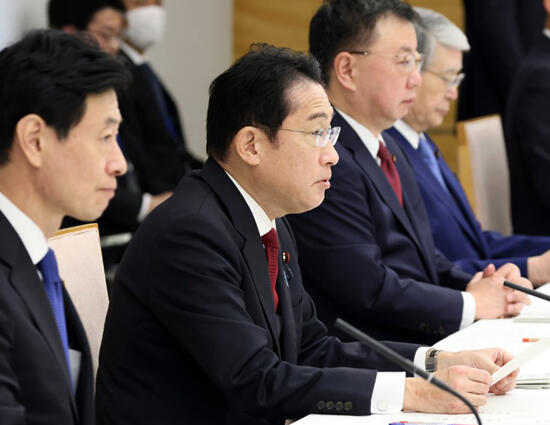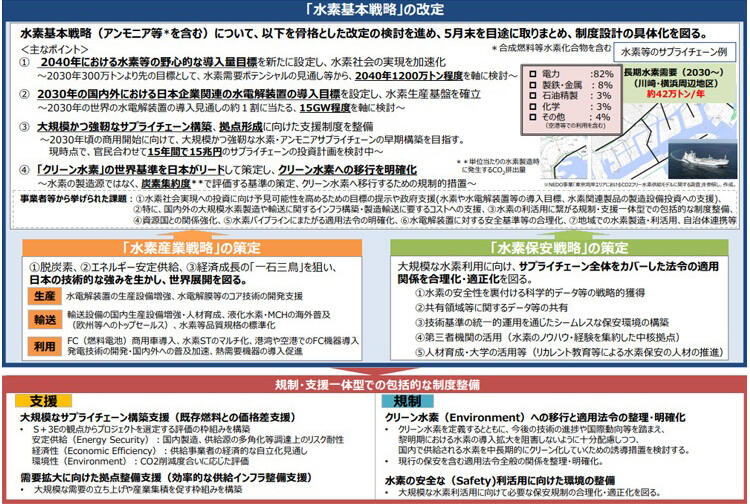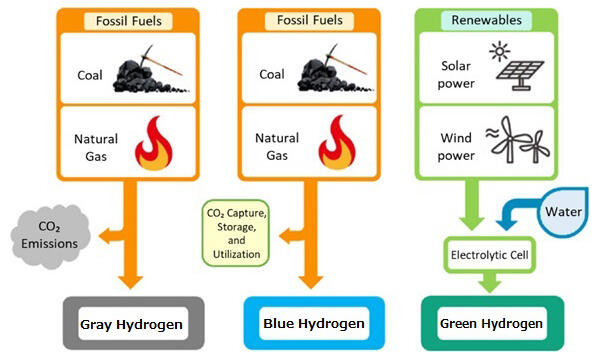In its effort to achieve a decarbonized society, the Japanese government plans to revise its current Basic Hydrogen Strategy to promote the use of hydrogen, which is attracting attention as a next-generation viable energy source. The draft of the strategy was adopted at the meeting of the Ministerial Council on Renewable Energy, Hydrogen and Related Issues held in April. The draft includes provisions setting forth numerical targets for increasing the hydrogen supply to approximately 12 million tons per year by 2040, while jointly investing 15 trillion yen from public and private sectors and providing a necessary basis for decarbonization.

(provided by the Prime Minister's Office)
Importance of implementation of the Basic Hydrogen Strategy under the holistic approach to promote renewable energy use
Japan, a country with poor natural resources, focused on hydrogen development early on, and Japanese hydrogen technologies are ranked among the best in the world. The government established the current Basic Hydrogen Strategy in 2017, ahead of the rest of the world. Since then, however, major European countries, the United States, and other countries have begun to develop hydrogen-based energy. Furthermore, international competition in the hydrogen energy field has been intensifying. A sense of crisis has driven the Ministry of Economy, Trade and Industry (METI) and other government agencies to revise this strategy.
Currently, Japan is noticeably lagging behind major foreign competitors in the hydrogen energy field who are overtaking the country in the deployment of fuel cell vehicles (FCVs) powered by hydrogen. Many challenges remain in providing solutions for stable hydrogen procurement, including lowering production costs, building out the infrastructure (such as the deployment of hydrogen fueling stations), and establishing scalable supply chains (supply network).

(Koto City, Tokyo; provided by Tokyo Gas)
Hydrogen energy uses do not involve carbon dioxide (CO2) emissions during combustion and are said to be the key to achieving net-zero greenhouse gas emissions by 2050. However, hydrogen is not "clean" if CO2 is released into the atmosphere during production. To increase the production of hydrogen by using renewable energy without emitting CO2, it is necessary to simultaneously promote the use of renewable energy. The importance of using renewable energy sources to produce hydrogen was also pointed out at the 2023 Group of Seven (G7) Ministers' Meeting on Climate, Energy and Environment held on April 15 and 16.
Can Japan retain its leading position in the international competition while aiming at decarbonization? Though it is uncertain that the revised strategy will help realize a decarbonized society, the challenge for Japan's public and private sectors is to take a holistic approach to implement the strategy.
Promises of utilizing hydrogen in the power generation field
Hydrogen is the most abundant element in the universe, with the atomic number one and symbol H. Its diatomic H2 gas is the lightest substance, weighing only approximately 1/14th the weight of air. As it produces a huge amount of heat energy when burned, it is promising for future use in hydrogen power generation and for rocket fuel, which has already been put to practical use.
In the power generation field using natural gas, hydrogen can be mixed in the fuel to reduce CO2 emissions. Power generation facilities fueled only by hydrogen are also being developed. Electric energy can also be obtained via a reaction with oxygen. Fuel cells with high power generation efficiency are becoming popular as a power source for FCVs and as household batteries.
After the Japanese government finalized its hydrogen strategy in 2017, Germany, the European Union (EU), and France established national hydrogen strategies in June, July, and September 2020, respectively. Spain, Italy, and the U.K. followed suit, steadily advancing the development of practical applications of hydrogen energy technologies. The Japanese government, therefore, must review and revise its 2017 strategy.
Urgent need to boost Japan's commitment in deploying low-cost production and distribution infrastructure
According to the draft of the hydrogen strategy finalized on April 4, the first step is to set numerical objectives to increase the current annual hydrogen supply of approximately 2 million, to 3 million tons in 2030 and 12 million tons in 2040, thus paving the way for achieving the goal of "20 million tons by 2050" set forth in the current strategy. The targeted amount of 12 million tons for 2040 is equivalent to that of filling the fuel tank more than two billion times with FCVs, which carry approximately five kilograms of fuel at a time.
Unlike existing primary energy sources, such as coal and oil, hydrogen must be "produced." Today, the production and transportation costs of hydrogen are higher than those of existing fuels, and there is an urgent need to enable the production of hydrogen at a minimal cost and spur deployment of the distribution infrastructure. Currently, the cost of hydrogen is approximately 100 yen per cubic meter, which is estimated to be 10 times higher compared to existing fuels.
According to the revised strategy, the early construction of large-scale networks of hydrogen producers must be achieved with the aim of commercialization by 2030 and must include the development of a system to bridge the price gap between hydrogen and existing fuels. The investment holds the key to boosting the hydrogen supply as well as the development of such a system, and the new strategy sets a policy to mobilize a total investment of 15 trillion yen from the public and private sectors over the next 15 years. The establishment of a concrete mechanism to secure the large investment of 15 trillion yen will be another challenge.

(provided by the Prime Minister's Office)

(provided by the Agency for Natural Resources and Energy)
Action plan for interagency synergy was also developed
Hydrogen is classified into three types based on the production process: Gray hydrogen is extracted from the gas generated by the burning of coal, petroleum, or natural gas, while CO2 is emitted during the hydrogen extraction. Blue hydrogen is produced by a method that captures CO2 generated or sequestrates it underground. Green hydrogen is produced by the electrolysis of water using electrical currents produced by renewable energy sources.
This classification scheme is the standard in major European countries. Most of the hydrogen produced in Japan and other countries today is gray hydrogen. For this reason, many have cited the need to increase green hydrogen uptake in the future if we are to ensure decarbonization and claim to use "clean energy." In the revised strategy, instead of using these three classifications, blue hydrogen will also be positioned as "clean," and a new standard for "clean hydrogen" will be introduced. The government intends to adopt its own definition of clean hydrogen and advocate it, but environmental groups and others have criticized such a policy.

(provided by the Agency for Natural Resources and Energy)
In conjunction with the revision to the hydrogen strategy, the government also formulated an action plan for interagency synergy to spur momentum toward achieving a wider introduction of renewable energy. According to this plan, a public-private sector conference will be organized to strengthen competitiveness in the offshore wind power business, as Japan can capitalize on its "geographic advantage." An industrial strategy and introductory targets for offshore wind power will be formulated by the end of FY2023.
Perovskite solar cells, which are gaining worldwide attention as next-generation solar cells, originated in Japan. They were developed by Professor Tsutomu Miyasaka of Toin University of Yokohama, who claims that they achieve high conversion efficiency, comparable to conventional solar cells. Japan is the world's second largest producer of iodine, the main raw material for perovskite solar cells, and the action plan calls for the establishment of mass production technology, the creation of demand, and the development of a production system from FY2023, with the aim of commercializing iodine before 2030.
Joint Statement of G7 Environment Ministers' Meeting expressly calls for hydrogen use
The G7 Ministers' Meeting on Climate, Energy and Environment held in Sapporo, Japan, completed its two-day agenda on April 16 with the adoption of a joint statement that called for "accelerating the phased reduction of fossil fuel use, for which no emission reduction measures have been taken," to achieve "net-zero" greenhouse gas emissions by 2050. The joint statement addressed the use of hydrogen and ammonia as fuels for power generation.

(provided by the Ministry of the Environment)
The joint statement explicitly states, "We will build the enabling environment to encourage safety use of hydrogen, promote relevant regulations, safety codes, and standards in order to accelerate deployment and emissions reductions from hydrogen use." Furthermore, the ministers stressed, "We also stress that countries producing low-carbon and renewable hydrogen for export and domestic use should fully benefit from and advance its development."
According to Ministry of the Environment officials, the Japanese government, which prides itself on being a global leader in the development of hydrogen utilization technologies, encouraged the other G7 members to agree on such wording in the joint statement. At the meeting, Japan advocated for perovskite solar cells and offshore wind power, already included in the action plan, as well as hydrogen transportation technology. Hydrogen is transported in the form of liquefied gas by cooling it to −253℃, compressing its volume to 1/800th of that of hydrogen gas, and loading it on a liquefied hydrogen carrier. The ministers of each country expressed their strong expectation that Japan would lead the way in the field of hydrogen transportation.

(provided by the Agency for Natural Resources and Energy)
Following the aforementioned joint statement, "climate and energy" was a key issue at the three-day summit of industrialized nations (Hiroshima summit) held in the city of Hiroshima, beginning on May 19. Leading the discussion as the chair, Japan was called upon to clearly present a roadmap for the deployment of renewable energy integrated with the use of hydrogen, as well as defossilization.
(UCHIJO Yoshitaka: Science Journalist, Kyodo News Visiting Editorial Writer)
Original article was provided by the Science Portal and has been translated by Science Japan.




